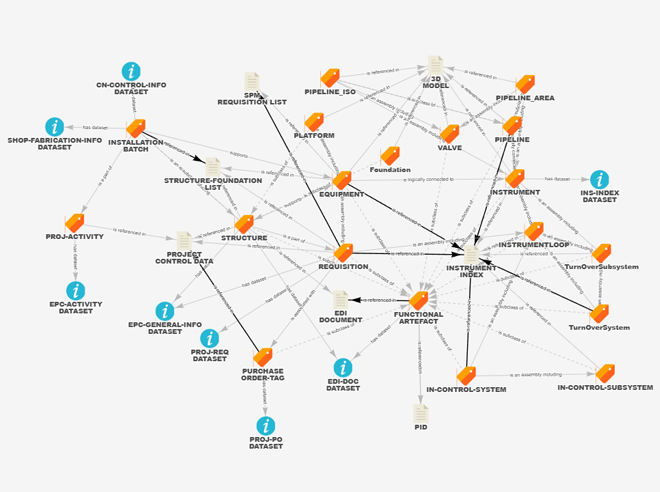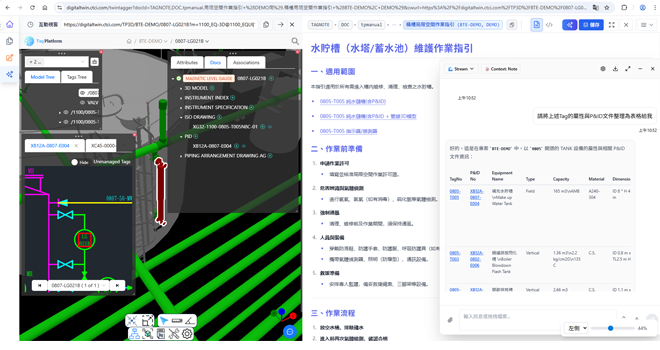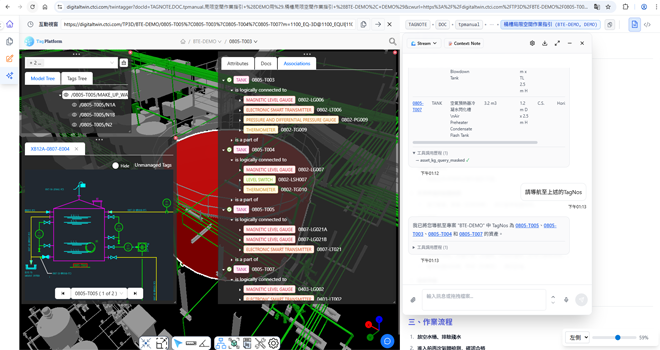Technology
技術分享
Applying AI with CTCI Digital Twin in the Engineering Industry
—Cheng-Wei Yi, R&D Director of Group Research and Innovation Center, CTCI
CTCI Group is committed to providing the most reliable global engineering services. We help clients execute large-scale projects worldwide and, along the way, accumulate massive amounts of design, procurement, and construction data. At project handover, these digitalized data are delivered alongside the physical plant for client retention and use. However, despite data digitalization, the lack of effective integration, search, and application mechanisms often prevents these valuable resources from being fully utilized. This article shares how CTCI’s Group Research and Innovation Center has developed the CTCI Digital Twin platform from a user’s perspective. By leveraging accumulated data, the platform establishes a convenient data integration system that helps clients activate their digital assets. In the future, the platform is set to incorporate intelligent AI applications, providing users with more efficient access to information, significantly enhancing management performance and data value.
Concept of CTCI Digital Twin
The CTCI Digital Twin platform represents a virtual replica of a physical plant in the digital world. As the CTCI team constructs a plant, data are simultaneously collected and integrated to build a digital twin. Upon project completion, both the physical and digital plants are handed over to the client. This platform enables flexible use of digital data. For example, by switching point of view and focus, users can have a real-time picture of specific objects, systems, or processes that meet project requirements. It also supports the creation of multiple applications such as intelligent leakage isolation and hazardous materials control, through application programming interface, or API. This enables users to gain deep insights into plant operations and support decision-making directly on the digital platform. To achieve this goal, it is necessary to create dedicated parsing engines for various types of handover data—from one-dimensional (1D) data, two-dimensional (2D) drawings, to three-dimensional (3D) models—when creating the CTCI Digital Twin. Engineering entities (known as Tags, such as equipment numbers, instrument IDs, or pipeline codes) become units of identification. Together, they help form a knowledge graph that clearly presents data relationships. The knowledge graph serves as a vehicle for information integration, enabling intuitive searches and dynamic expansion to mount additional information. CTCI Digital Twin applies ontological technology and builds a Tag Map as the framework for managing this knowledge network. Defined jointly by CTCI and the client, this backbone ensures a high level of customization and data quality, forming a robust schema for the platform.

Tag Map (Ontology)
Based on this framework, CTCI Digital Twin has developed multiple web applications, such as Tag Search, a data exploration tool akin to Google search engine; Tag Explorer, which enables multi-dimensional views of data; and Tag Note, an interactive note-taking tool for knowledge transfer. These applications are deployed on the cloud through complete data pipelines and data governance. They also provide well-designed APIs for browser-based data access and operations. Users with programming skills can even build their own extensions.
Proof of Concept: Integrating AI Agents with CTCI Digital Twin
The strength of the CTCI Digital Twin lies in effectively managing and integrating critical lifecycle data of engineering projects, ensuring data are searchable and usable. However, the sheer volume and complexity of data make the platform challenging for some users. The development team explored the potential of the rapidly evolving AI technologies in addressing this issue. Notably, CTCI Digital Twin’s high-quality datastores and standardized APIs create a solid foundation for advanced AI applications. The knowledge graph provides AI agents (which can make decisions and taking actions autonomously, as well as making judgments and carrying out certain missions) with reliable data sources, enabling users to search data by conversing with AI. Furthermore, these APIs can integrate seamlessly with the prevalent Model Context Protocol (MCP), allowing AI agents to support workflow automation in controlled and secure environments, greatly enhancing user experience. In 2024, the CTCI Digital Twin development team successfully conducted a Proof of Concept (POC) using ChatGPT’s customization feature. The key mechanism involved configuring CTCI Digital Twin’s OpenAPI schema within the ChatGPT, enabling it to understand which APIs from CTCI Digital Twin are available for call. When users ask the customized ChatGPT questions, the customized ChatGPT would break them into a series of steps to make API calls to CTCI Digital Twin, before retrieving the required data and presenting clear, well-structured answers. The POC achieved several important goals. It allowed the team to validate the effectiveness of agentic workflows, confirming that users can easily access needed information through AI without learning complex operations, and verify technical feasibility. This provides a clear path forward for issues such as data privacy and system integration.
AI Agent Applications and Outlook in Engineering
The POC demonstrated the potential for integrating large language models with proprietary software services. Building on this, CTCI Digital Twin will continue expanding AI applications, focusing on AI agent integration as the next stage of development, with the following objectives: 1.Enhancing User Experience with Natural Language To allow users retrieve information more efficiently, CTCI Digital Twin will integrate AI agent technologies so that users may send requests to AI in natural language. From asset information queries to automated document drafting, uploads, updates, and even AI-guided navigation, users will be able to interact with the system as if conversing with a human. Free from complicated instructions or interface, this lowers the learning curve and makes information access far more efficient. 2.Smart Asset Information Retrieval AI agents can interpret user queries in natural language, then quickly locate and retrieve relevant asset information in CTCI Digital Twin’s extensive knowledge graph. Take “asset information retrieval” as example, instead of navigating menus or inputting specific IDs to locate equipment design data, users can simply send retrieval request in natural language, and the AI will automatically gather and present the complete information, improving both efficiency and user experience. At present, the development team has integrated the latest technologies into CTCI Digital Twin, including the Model Context Protocol and initial functions of the knowledge graph, to test the applicability in various scenarios. 3.Automated Document Drafting Besides information retrieval, AI agents can also draft documents automatically. Through text commands on the interactive Tag Note tool, the AI will automatically generate content such as maintenance instructions, operating guidelines, or other notes based on the dialogue and data. This greatly enhances knowledge management efficiency and convenience. The figure below illustrates an example of how Tag Note operates with language in combination with the knowledge graph. Interactive notes for Digital Twin Apps operations can be generated from the AI agent's responses—for example, the user can ask the AI in natural language or conversation form to fetch the target equipment's information and the P&ID drawing, and present them as clickable elements for the user to interact with.

A figure of how Tag Note operates with language
4.Automated Uploads and Updates Another advancement is to scale up the platform’s capability through integration of AI agents, enabling automated uploads and updates. Users can instruct the AI in natural language to upload data to the platform or update figures according to the latest status, thus reducing manual workloads and ensuring real-time accuracy of information. This ensures smoother and more automatic digital asset management experience. 5.Automated Navigation By integrating the latest MCP framework, Digital Twin Apps can serve as the AI agent’s “hands,” offering automated navigation. Proof of Concept results show that users can converse with the AI agent to automatically navigate Tag Explorer to desired areas, such as specific 3D models.

A figure of automated navigation
While providing intelligent, user-friendly services, CTCI Digital Twin also places great emphasis on sensitive asset data protection. Since APIs handle highly structured data, the development team has implemented strict masking mechanisms to prevent AI agents from accessing sensitive information unexpectedly. This ensures users enjoy intelligent features with full confidence in data security and privacy.
Conclusion
CTCI Digital Twin is more than a digital asset management platform—it is a core tool connecting engineering expertise with intelligent applications. By integrating knowledge graphs, standardized APIs, and AI agents, the platform transforms complex EPC data into actionable, real-time decision support. Going forward, the development team will continue to expand smart applications of CTCI Digital Twin, from enhancing user experience to driving process automation, helping clients achieve efficient lifecycle maintenance and operations, as well as move toward an even more intelligent digital plant.
